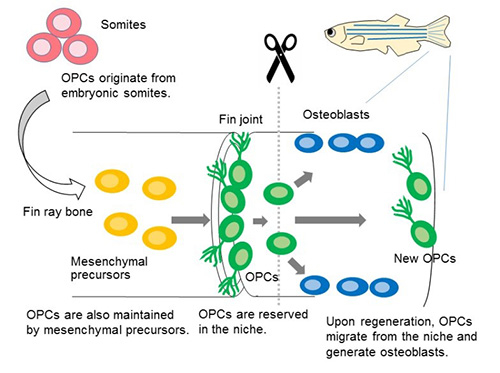Elucidation of bone regeneration mechanism
Fish have the extraordinary ability to regenerate lost fins and other appendages containing cartilage and bone. The cells responsible for the regeneration offer new clues on how to regenerate tissues in humans. Researchers at Tokyo Institute of Technology (Tokyo Tech) have found a dormant progenitor cell population in zebrafish that regenerates bone cells, or osteoblasts. The study can be read in Developmental Cell.
How osteoblasts are supplied during bone regeneration has been controversial among bone researchers. According to Atsushi Kawakami, an Associate Professor who specialises in tissue regeneration and led the study, scientists disagree on how these cells are made.
The new study uses genetically engineered transgenic zebrafish to show that a population of progenitor cells marked by high expression of matrix metalloproteinase 9, an enzyme that catabolises collagens, provides osteoblasts during regeneration.
Kazunori Ando, a graduate student who conducted the experiments, calls these cells osteoblast progenitor cells (OPCs). Consistently, eliminating OPCs prior to tissue injury significantly impaired bone regeneration. Overall, the study shows that OPCs are essential for bone regeneration.
.jpg)
Visualised OPCs in niches using transgenic zebrafish
The researchers further investigated the developmental origin of OPCs and found that OPCs are derived from embryonic somites and reserved in niches of bone-forming tissues in adult animal as the source of osteoblasts.
Embryonic somites produce osteoblasts during vertebrate development, but its relationship to adult osteoblasts was not known. The study revealed that OPCs derived from the somites are the dormant cells for later production of osteoblasts in adult animal.
In conclusion, the findings suggest that a lineage of bone-producing cell, which are specified in embryonic somites, are maintained throughout the animal lives as progenitor cells for bone regeneration and also for bone maintenance.
"We use animal models because they show us a number of essential cellular and molecular mechanisms behind our existence. Considering the higher bone regeneration potential in zebrafish, OPCs will be a potential target for enhancing bone regeneration in mammals" said Kawakami.

Summary of the study
The study revealed that OPCs originate embryonic somites, develop through mesenchymal precursors to settle in niches of bone-forming tissues like the fish fin ray. OPCs are activated upon tissue injury and recruited to repair bones.





